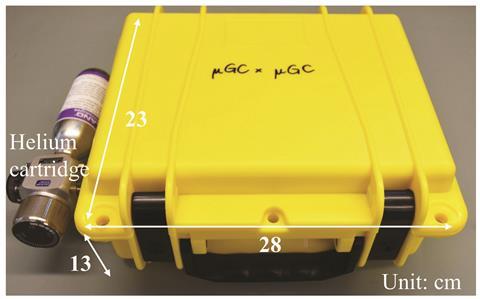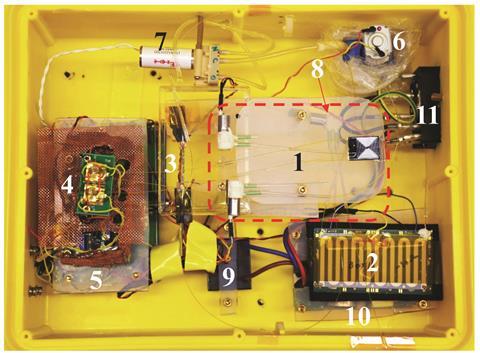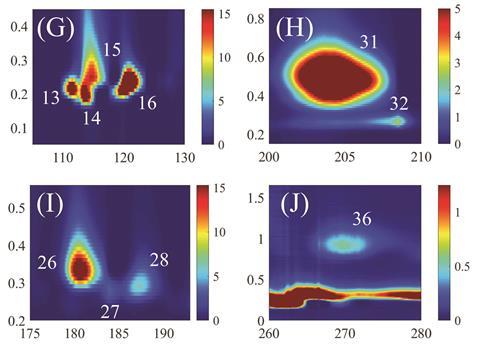
The image that comes to mind when you hear gas chromatography (GC) would probably not resemble a lunchbox-sized apparatus. Yet researchers from the University of Michigan created a portable GC that’s very light-weight and efficient.
When analysing vapours, there’s a few ways to go about it, but the gold standard for gas phase detection is gas chromatography (GC) coupled with mass spectrometry. However, you need complex and very expensive machines to do these analyses. ‘That’s why we develop GC that is portable, small, light-weight and a lot cheaper while not diminishing the performance’, says Xudong (Sherman) Fan, professor of Biomedical Engineering at the University of Michigan. Currently, ‘portable’ GC’s weigh in at around 15-30 kg, but Fan’s version is no more than 4 kg.
Why would you need GC to be portable? ‘Well, let’s say you’re an environmental scientist and you want to take a sample from a polluted area’, Fan explains. ‘You would have to take the sample back to the lab and analyse it there. It’s costly and time consuming. If you could do a measurement on the spot, that would be very beneficial.’ Fan and his team designed their current portable GC with target analysis in mind. ‘Our machine can do complex separations, but it excels when you’re looking for specific target molecules instead of wanting to separate every molecule in a sample.’
’We are far beyond the prototype stage’
In the magazine Microsystems & Nanoengineering, the Michigan researchers showed that they could separate a mixture of forty molecules in a matter of minutes. ‘But we can do more, I think we can go to a hundred without any danger of co-elution’, Fan says. ‘In the paper we used alkanes, aromatics and other common lab molecules, though theoretically we can separate nearly any compound depending on which separation column we use.’
Integration
Based on the properties of the molecules you want to separate, you need different columns (where the separation takes place). ‘We’re aiming at a plug-and-play version, where you can adjust every part of the portable GC to your needs.’ Already the system has a very modular character. It currently has two columns so you can do 2D gas chromatography. ‘But you don’t always need that ability, so we designed it in a way that lets you choose whether you want 1D or 2D separation.’

The most challenging part of the project was the integration of all the parts. Fan: ‘There are many components to a GC. Ideally you would want them all in a single chip, which is something we’re still working on. But the GC we published about already has an integrated modulator and second-dimensional column.’ Integrating all the parts will reduce the cost of GC’s significantly. Current GC/MS machines can cost up to $150.000, but Fan wants to produce his version for less than $1000.
The 2D GC consists of two columns, a pneumatic modulator and two micro-photoionization detectors (µPID’s). ‘The detectors are an important part of the GC system’, Fan says. ‘PID’s use vacuum UV light to ionize molecules. The big advantage to PID’s compared to other detectors is that it is nearly non-destructive; it doesn’t destroy your molecule which is essential when you want to pass the sample to the second-dimensional column for further analysis.’

Future steps
Fan is certain that the portable 2D GC system has potential for commercialisation. ‘All components can be mass produced and assembled. The technology readiness level is very high, we are far beyond the prototype stage.’ The group already has some collaborations with colleagues and is looking into collaborations with industrial partners.
In the meantime, Fan and his colleagues have created GCs even smaller than the current one. ‘Since there’s a lot of room in the box, we were able to reduce it to a handheld version of just 1,5 kilograms and 1 litre in volume’, says Fan. ‘And we created one that is even smaller, which you can wear in a pocket or on a belt, which we will publish about later this year. But the current version is already useful for field studies. We hope our miniaturised system helps the community in going even smaller and more efficient.’













Nog geen opmerkingen